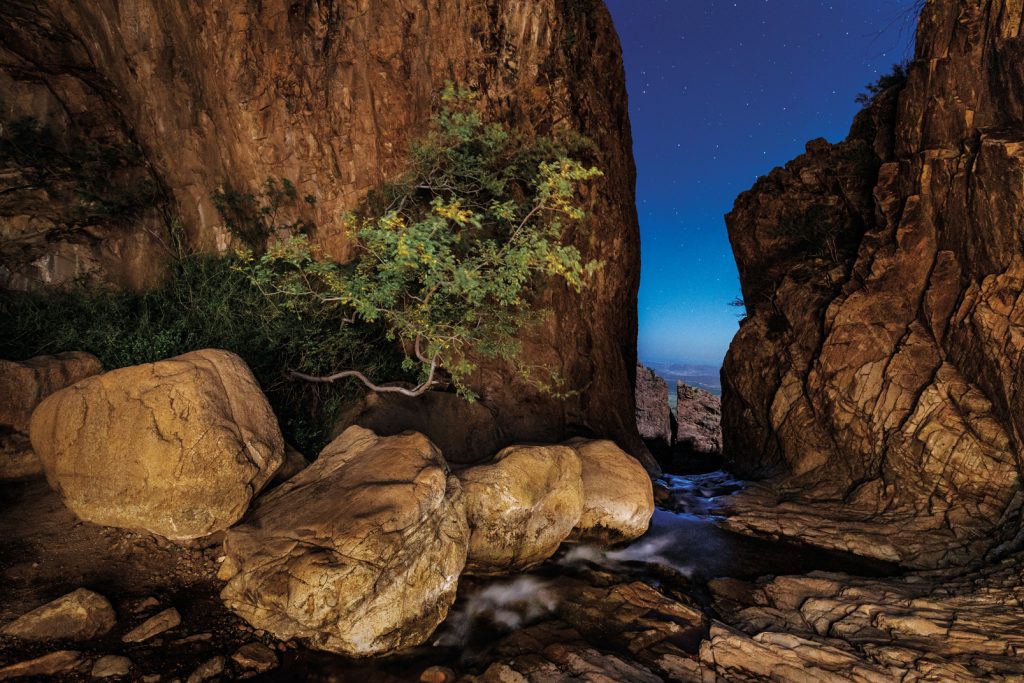If you’ve enjoyed the scenic photography that characterizes Texas Highways, you’ve enjoyed the photographs of Sean Fitzgerald. Based in Dallas, Fitzgerald is one of Texas’ leading photographers of nature and wildlife, and a frequent call for Texas Highways Photo Editor Brandon Jakobeit. “Sean always surprises me with his creativity,” Jakobeit says. “I know that even under the worst weather conditions he is going to come away with a beautiful shot. And when the conditions are perfect, it’s going to be spectacular.” The February Texas Highways—the collector’s edition celebrating Big Bend National Park 75th anniversary—features Fitzgerald’s photographs in the “Big Bend for Everyone” feature and in remarkable nighttime images of the Chisos Basin and the Window pour-off. When shooting the Window, Fitzgerald made this time-lapse video documenting his hike and the shot. We asked Fitzgerald about the challenges and rewards of shooting in Big Bend.
TH: What are the biggest challenges of taking photos in Big Bend?
SF: Big Bend really is big, in fact it is bigger than the state of Rhode Island. Getting from point A to point B inevitably takes time, whether by car or hiking on foot. As a photographer working on a schedule through a “shot list,” that reality presents a logistical challenge. I have learned to scout my locations and plan my shoots carefully so I can get as many shots as possible in the same general area. At sunrise and sunset, when the light is beautiful but fleeting, I already have a general plan, and I am not rushing around frantically looking for something to photograph.
TH: How do you carry all your equipment with you?
SF: When I was younger, with more testosterone and a lot less sense, I would pile a ton of equipment into one big camera bag, throw it on my back, and venture out to look for photos. I have gotten a little bit smarter since then. Nowadays I use my truck as an equipment base camp. When I stop to shoot or hike to a location, I just grab what I think I will need for that particular shoot, and I don’t worry about taking equipment for every possible situation I might encounter. I have learned the value of being lighter, moving faster, and making what I do have with me work. Most of the time I just carry one camera, two lenses, my tripod, and a flash or led light.

Photo: Sean Fitzgerald
TH: You used light-painting for the Window shot. How does light-painting work?
SF: Digital photography makes shooting at night or in low light easier and a lot of fun. The camera sensors are incredible, and the ability to immediately see what you just shot on the back of the camera really opens up creative possibilities. In these low-light situations, you can set your camera so that the exposure is long enough for you to “paint” the foreground scene with light from a small LED flashlight or light panel.
I set up my camera on a tripod, set my focus point, then find an overall exposure for the scene (such as for the dusk or dawn light, or a night sky). Usually my exposure is around 20-25 seconds long. Then I take another shot at that same exposure while also sweeping the foreground with five to 10 seconds of light from the LED. It doesn’t take much light, and you don’t want to overdo it. Often you have to warm the bluish light of the LED a bit, either with an orange gel taped to the front of your flashlight, or an LED panel that lets you choose your color temperature. Once you get the hang of it, it is a lot of fun!
At “The Window” for my wide shots, I pointed the LED away from the scene and swept it around the canyon walls behind me. This made the light extremely soft as it reflected off those walls and into my scene, and I managed to get all the light into a nice balance. For the vertical images where the flowing water sweeps right under the camera, I used a little flashlight with a really tight beam to paint just the stream. That made the white ribbon of water really stand out against the dark rock.
TH: What’s your favorite place to take pictures in Big Bend?
SF: Tough question! I love so many places in Big Bend that it is really hard to choose one—it is kind of like trying to name your favorite child. For sheer splendor, it really is tough to beat the view from the South Rim of the Chisos at dusk, dawn, and night, especially since you have earned that view with a long, tough hike up from the basin. It is the one place in the park that really lets you see the “Big Bend.” From the edge of the South Rim you can look to your right and catch a glimpse of the Rio Grande as it flows south, then to your left where the river bends back to the north before winding its way back to the Gulf. Everything on the horizon is in Mexico. I still get goosebumps every time I think about that view.
TH: What’s special about Big Bend to you?
SF: Big Bend is the kind of place you fall in love with and then return to over and over. It always shows me something new, as long as I am patient and observant and willing to explore the edges of the light and travel to some of its more remote corners. The light early and late is sublime. The night skies are extraordinary. Rains quickly turn lunar landscapes into fleetingly lush carpets of wildflowers and dry washes into suddenly flowing streams and waterfalls. Wildlife reveal themselves in brief but thrilling encounters, especially at dusk and dawn. Big Bend always fills me with awe and inspiration, and I can’t wait to return.








